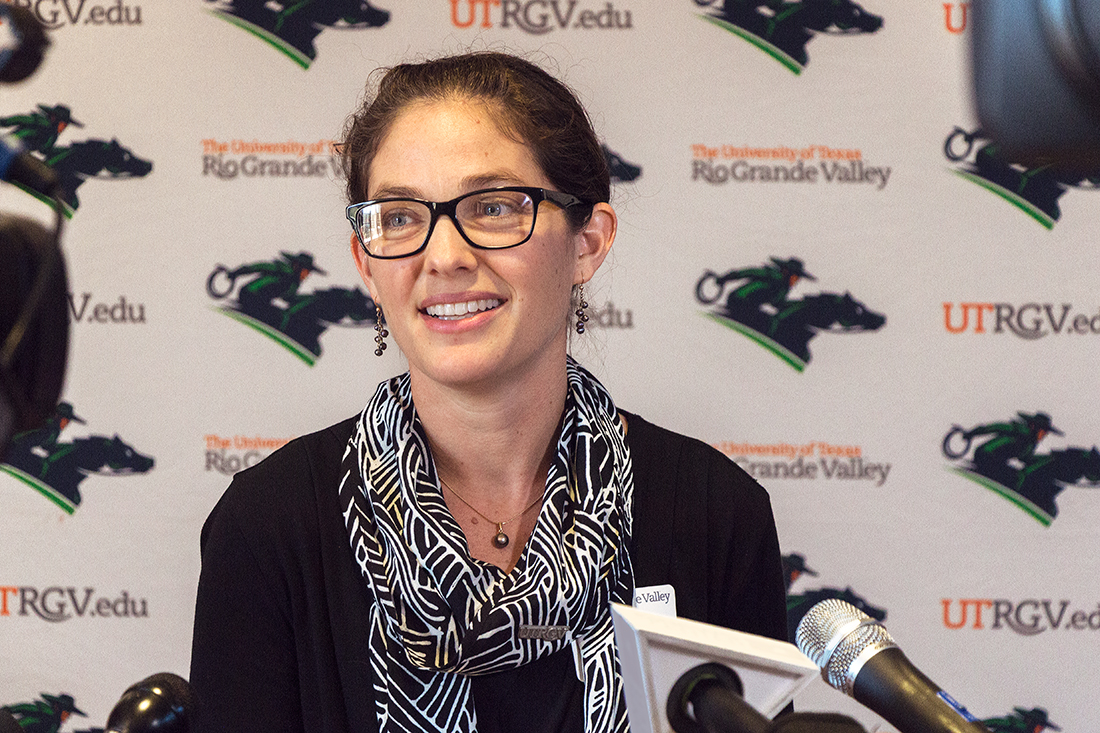
Joey Shapiro Key, director of education and outreach for the Center for Gravitational Wave Astronomy and an assistant research professor of physics, is interviewed Thursday by the news media after scientists announced the discovery of gravitational waves. MARIO GONZALEZ/ THE RIDER
Scientists announced Thursday that gravitational waves do exist, calling it a “fundamental science discovery.”
“Ladies and gentlemen, we have detected–gravitational waves. We did it,” David Reitze, LIGO Laboratory executive director, told a roaring crowd during a news conference that was live streamed in the Student Union’s Gran Salón in Brownsville.
The UTRGV Center for Gravitational Wave Astronomy (CGWA), a member of LIGO, streamed the conference from the National Press Club in Washington, D.C.,where Reitze announced the existence of gravitational waves, which were observed Sept. 14 by the two Laser Interferometer Gravitational wave Observatories (LIGO).
During the presentation, Reitze compared the discovery to Galileo’s work, which started the era of modern observational astronomy.
“I think we are doing something equally important today,” he said. “I think we are opening a window on the universe, a window of gravitational wave astronomy.”
Joey Shapiro Key, director of education and outreach for CGWA, said gravitational waves are a fundamental science discovery that have never been directly detected before.
In 1916, Albert Einstein predicted the existence of gravitational waves. A hundred years later, LIGO observed a cataclysmic event involving the collision and merger of two black holes producing a gravitational-wave signal, GW150914, which took place in a galaxy more than one billion light years from Earth, according to information provided at the news conference.
Gabriela González, LIGO Scientific Collaboration spokeswoman, said they have been analyzing data from detectors in Livingston, La., and Hanford, Wash. LIGO uses these two laser interferometers to analyze the physical properties of light
and space to detect gravitational waves.
An interferometer consists “of two ‘arms’ at right angles to each other, along which a laser beam is shone and reflected by mirrors at each end.
When a gravitational wave passes by, the stretching and squashing of space causes the arms of the interferometer alternately to lengthen and shrink, one getting longer while the other gets shorter and then vice-versa,” according
to LIGO documents.
In other words, the two arms detect movement between each other. That movement is called gravitational-wave strain. The strain is expected to be the width of a proton.
“The total power output of the gravitational waves during the brief collision was 50 times greater than all of the power put out by all of all stars in the universe put together,”said Kip Thorne, LIGO co-founder. “Because it was so brief, the total energy was not that big. It was only like taking three suns, annihilating them and putting them in gravitational waves. Well, that’s kind of a lot.”
Thorne predicts that over the next decade or two, four gravitational wave windows to the universe will open. The four windows would be measured in intervals of milliseconds, minutes to hours, years to decades and billions of years.
The LIGO Scientific Collaboration is composed of more than 1,000 scientists, of whom 30 are from the university, Key
said.
“We work … across the board, really,” she said. “We help with mitigating noise in the detectors. We are also astrophysicists; we do data analysis, parameter estimation we call it. So, we’re involved in, really, every piece of this discovery and going forward with the LIGO Observatories.”
The UTRGV CGWA was founded in 2003 with grants from the National Aeronautics and Space Administration and the National Science Foundation.
Juliet V. García, who served as president of UTRGV legacy institution UT Brownsville and attended the news conference, said this was a huge accomplishment.
“It affirms that we have been in the right scientific arena, on the cutting edge of that very frontier and it worked,”
García said. “That is, they identified gravitational waves, proving Einstein’s theory and it was students and professors from here that helped do that, so it’s a huge accomplishment.”
Key said the design for the detector of advanced LIGO is on track for 2018.
“So, by then, we’ll have our even more sensitive detector and we’re going to be detecting pairs of black holes like these. It could be every day,” Key said. “So, I mean, all of a sudden we’re going to have a new map of the whole universe, of where are black holes. What are their masses? What are they like? How do they form? How do they get there? So, it’s really a big piece of our exploration of our universe.”






